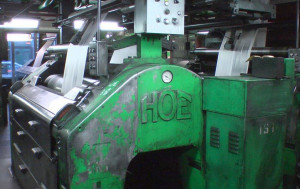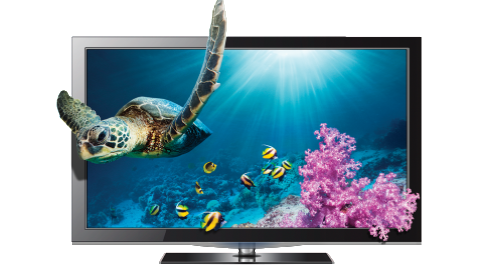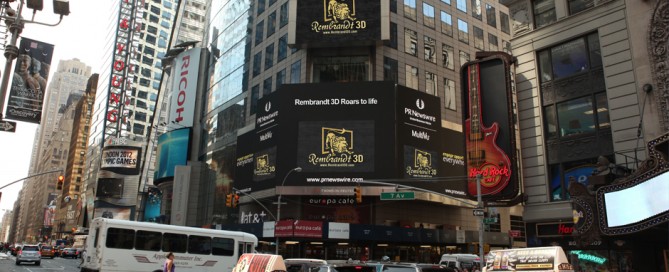I’ve written several articles about 3D TV. This isn’t that, but it’s a cousin. Indeed, it’s not about a TV at all, but an Android tablet. But it’s TV that has pushed the technology and is therefore worth address first.
From the beginning, I’ve written that 3D TV with glasses is a problematic technology that doesn’t have a future. And that turned out to be the case. The simplest explanation is that it’s not how people watch TV in a house with family and other distractions around. Glassless 3D, though, is another matter. Also known as “auto-stereoscopic” technology, it offers a real future and benefit. Mostly, I’ve written about a company called Stream TV Networks, which licenses a technology called Ultra-D, which is quite remarkable and works wonderfully. The first few TV sets using Ultra-D technology are slowly hitting the market, but there still have been many delays. They have additional plans to develop glassless 3D tablets, but those are still in the beta stages.
Ultra-D isn’t the only technology out there, however. I’ve seen some others, and they’ve been interesting but problematic. And that brings us to the Rembrandt Maestro, which appears to be the most promising, though still with some questions.
REMBRANDT MAESTRO Glasses-free 3D Android tablet
 This will be a slightly different review than most—more of a double review. The core of it, though, is the Rembrandt Maestro, which is a 10” Android tablet that can run videos in glasses-free 3D. It also can auto-convert 2D video to glasses-free 3D. (And photos, as well.)
This will be a slightly different review than most—more of a double review. The core of it, though, is the Rembrandt Maestro, which is a 10” Android tablet that can run videos in glasses-free 3D. It also can auto-convert 2D video to glasses-free 3D. (And photos, as well.)
The tablet itself is a very respectable Android device. It’s full-featured, and runs the Android 4.2.2 operating system quite well. It’s responsive and comes with a solid selection of apps pre-installed. Programs run on a quad-core processor providing respectable speed. I did find the tablet to be a bit on the heavy side.
One other small quibble. When you plug in the included charger, there’s no light on the tablet to show that it’s charging, or to change color and show that it’s fully charged, or at least to open a graphic that’s begun charging. Obviously, when it’s plugged in, you can see that is, but I find a light helpful to know that the charging is working.
The Maestro comes with 16 MB of RAM, a bit small for promoting itself as a PC, though it’s okay for limited heavy-use and there’s a micro-USB slot to expand capacity. It has a 5MP rear camera (not the most powerful around, but it suffices) and a small .3 MP front camera. When you take a picture, content can automatically convert to 3D on the tablet.
The display supports 1080p video. I thought the image throughout the tablet was good, though not with the sharpest crispness some people. Audio quality was fine, though obviously you’re not going after audiophiles.
 It also comes with a pretty nice keyboard and protective case. I found the keyboard responsive and good to work with. The keys are fairly small, though, so people with chubby fingers would likely have a problem. The case is quite nice and folds out easily to become a stand.
It also comes with a pretty nice keyboard and protective case. I found the keyboard responsive and good to work with. The keys are fairly small, though, so people with chubby fingers would likely have a problem. The case is quite nice and folds out easily to become a stand.
When I was sent the tablet, I was told that I might have to hold the On button two times for about 10 seconds each. And I did have to—it’s certainly not the most efficient way to get up-and-running. Also, oddly, it was a bit difficult to turn the device off, and tended to require a few attempts. I don’t know if this was just because it’s an early production model, though, or if there was some manufacturing glitch. I’m going to assume the former, though don’t know for absolute certain if that’s the case.
More to the point of all this is the glassless 3D capability. That’s the reason to pay attention to the Rembrandt Maestro.
I first tested the 3D videos that come came installed which had been converted from 2D, and was unfortunately underwhelmed. (I’ve seen the 2D-to-3D conversations by the aforementioned Ultra-D, and they’ve been wonderfully impressive, so I know that conversion can work.) Here, it was still pretty flat without much sense of depth. Same with the converted photos.
There are two scrollbar-like settings that you can adjust to change the focus and depth of converted videos, and to find the best “sweet” spot for viewing, but I felt that neither made much difference.
Then I checked out a couple of native 3D videos that were installed on the tablet, neither that required any converting, and both about Frank Lloyd Wright and the famous Fallingwater House in Pennsylvania. (More about them later.) It was a significant difference. The native glassless 3D video was quite wonderful.
With the native 3D, there was a very noticeable depth in watching the videos— and again, remember, this is auto-stereoscopic, so no glasses are needed. The depth wasn’t always pronounced, but that’s normal with any 3D, and it also depends on how the shot was set-up by the filmmakers—sometimes though the depth-of-field and 3D image was profound, giving a wonderful, natural sensibility. The video was also very sharp—quite crisp and clear.
In native 3D mode, there’s only one scrollbar setting, to adjust focus and find the sweet spot. You can’t adjust the depth of 3D (you can with Ultra-D), and I found that you are a bit limited in the viewing distance. For instance, unless you have someone else helping out, you really can’t adjust the image any farther away than…well, the length of your arm. It’s not a big deal, but it would be nice to be able to set the tablet on a desk and sit back a ways, if you wanted to. But ultimately, all auto-stereoscopic 3D has a sweet spot, so the fact that this one may be a little bit closer is fine.
The bottom line is that it plays native glassless 3D video very well. The same with native 3D photographs. It can also play 3D games, of course. In addition, there’s an HDMI output so that you can play the 3D image on a 3D monitor or 3D TV. (None of the documentation said whether it had to be an auto-stereoscopic TV or monitor, rather than one which requires glasses, though I would expect so.)
The Rembrandt Maestro retails at the time of writing for $399. They have a deluxe model for $449, but as far as I can tell, the only difference I can tell is that it includes the two Frank Lloyd Wright videos. They’re wonderful and would be a treat to have, but I don’t think they’re worth the extra $50.
Is the Rembrandt Maestro something that should be your Android tablet of choice? It’s a solid device, but honestly I think that right now for most people its use is probably limited. It’s also a bit heavy, and somewhat more expensive compared to the competition. And the amount of 3D content is limited right now. However—if 3D movies (or games, which are much more prevalent) are important to you, a glassless 3D tablet is an intriguing device and greatly-more usable than one with glasses, since the whole point of a tablet is its ease of portability.
The thing is, however, that there is another value to a glassless 3D tablet like the Rembrandt Maestro, that expands beyond just home consumer use. Which, in part, brings us to the oddity of the other review.
Fallingwater in 3D, the House Tour
I don’t tend to review movies here (“tend” will be defined in this instance as “never”), but I thought this was a deserving change of pace, since the quality of watching a glassless 3D movie is so integral to the experience—and use—of the tablet. This won’t be in-depth, but still, I think, worthwhile.
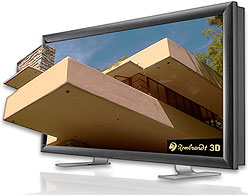 Actually, there are two glassless 3D movies included on the tablet, both from the same filmmaker, Ken Love. One is a short five-minute work mainly on Frank Lloyd Wright, using Wright’s own voice for the narration. It’s enjoyable, and the glassless 3D is effective. But it’s the other film, a 36-minute movie on Fallingwater House in Pennsylvania that’s the centerpiece.
Actually, there are two glassless 3D movies included on the tablet, both from the same filmmaker, Ken Love. One is a short five-minute work mainly on Frank Lloyd Wright, using Wright’s own voice for the narration. It’s enjoyable, and the glassless 3D is effective. But it’s the other film, a 36-minute movie on Fallingwater House in Pennsylvania that’s the centerpiece.
It’s not just the centerpiece because of the length and craft of the film, but also for showing the benefits of glassless 3D. What inspired the film to be made is that Fallingwater House is very difficult to get to by some people, particularly those who are disabled. It is 117 steps to walk up through a challenging natural climb. Providing a filmed tour of a locale is fairly common among museums and such venues, but most still don’t really touch the experience fully. In fact, Frank Lloyd Wright himself said long ago (and presciently) that 3D-film was really the best medium for viewing architecture. And so, a 3D movie like this goes a long way to bringing a place like Fallingwater to far greater life than would be otherwise. And a glassless 3D movie takes that reality even further.
Which brings us to Ken Love’s movie. Love is a film director, still photographer and producer based out of Pittsburgh. He has worked on more than 30 National Geographic TV specials, and won two Emmys for them, in Individual Achievement in Sound Editing.
 The film is quite wonderful. One of the things that Ken Love understands about 3D is that you don’t get the most effect by camera movement or horizontal design or anything “shooting out” at the viewer, but by layering what’s in the frame. One of the first, most-pronounced 3D effects in the film comes in shots of a butterfly on the fore-edge a flower, fluttering its wings. It’s simple, but it shows craft and a sense of space. The film is more than just 3D visuals, though, it’s a good movie, period, with interesting history on the building of the house, a tale that began with department store magnate Edgar Kauffman getting involved with Frank Lloyd Wright in 1934, when the architect’s career was stalling. However, their son worked for Wright at Taliesin in Wisconsin, so they were interested in his work. It’s all illustrated with impactful black-and-white photos.
The film is quite wonderful. One of the things that Ken Love understands about 3D is that you don’t get the most effect by camera movement or horizontal design or anything “shooting out” at the viewer, but by layering what’s in the frame. One of the first, most-pronounced 3D effects in the film comes in shots of a butterfly on the fore-edge a flower, fluttering its wings. It’s simple, but it shows craft and a sense of space. The film is more than just 3D visuals, though, it’s a good movie, period, with interesting history on the building of the house, a tale that began with department store magnate Edgar Kauffman getting involved with Frank Lloyd Wright in 1934, when the architect’s career was stalling. However, their son worked for Wright at Taliesin in Wisconsin, so they were interested in his work. It’s all illustrated with impactful black-and-white photos.
(Obviously, no 2D images will give any sense of the 3D experience, but I offer them here to give a perspective of the views—both inside and out—of what the 3D technology has available at its fingertips.)
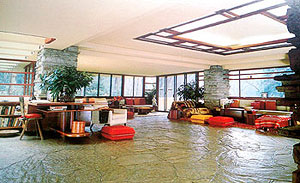 Ultimately, of course, it’s the 3D which leaps out (literally) in the film. And seeing the fascinating house in its place in nature has increased impact when viewed in spatial perspective of the multi-level house, its famous waterfall, the prominent gulley and surrounding woods. We almost expect to see that, though. What is less expected is how moving the interior of the house is with the rich depth of field. As the 3D cameras travel around rooms and their unique angles, looking outside into the natural environment, and then heads up into the upper rooms, it’s remarkable how much the sensibility of the house comes alive so vibrantly.
Ultimately, of course, it’s the 3D which leaps out (literally) in the film. And seeing the fascinating house in its place in nature has increased impact when viewed in spatial perspective of the multi-level house, its famous waterfall, the prominent gulley and surrounding woods. We almost expect to see that, though. What is less expected is how moving the interior of the house is with the rich depth of field. As the 3D cameras travel around rooms and their unique angles, looking outside into the natural environment, and then heads up into the upper rooms, it’s remarkable how much the sensibility of the house comes alive so vibrantly.
The narration is quite well-done, as well, something not always the case in “tour” movies like this, which can be dry. And though the voice-over work is intentionally low-key, bordering on monotone, it’s actually effective here and calming, fitting the nature of the…well, nature.
What stands out above the quality of the work is how viable glassless 3D is for use such as this. We tend to think of consumer technology as just being for home use, and while glassless 3D tablets do have home use value, I think that thinking of the devices in only that way is very limiting to this technology.
There are many tourist venues and “living museums: that have poor access for the disabled—or the elderly or very young. And not only does 3D add an impact to the experience that a 2D film can’t reach, but making it glassless 3D on an easy-to-carry tablet makes the experience all the more natural (and removes the expense and maintenance of keeping glasses around). But even this specific movie doesn’t have to be used only at this one venue in question. I could see any Frank Lloyd Wright museum in the country offering the Fallingwater glassless 3D video to rent and watch on the spot. Or offer it for sale. For that matter, it could be offered to rent and watch at any architectural museum—or any museum, period. And that only takes into consideration singling out Frank Lloyd Wright here. Obviously, the technology would be appropriate for any architecture site or any natural location or “living museum” venue where getting a richer, full-visual experience would be important.
So, while Fallingwater in 3D, the House Tour is extremely good on its own, I think its greatest value is in showing how such technology and tablets like the Rembrandt Maestro can be used on a much wider scale.
TWW Notes
- • Delta Airlines will soon be adding an impressive and actually helpful feature to its app. Upcoming, they will be updating their service at 84 international airports in the U.S. to allow for RFID technology (radio frequency ID) to track luggage. Once this rollout is finished, passengers themselves will be able to follow their luggage across airports and planes on their Fly Delta app. Pins can mark the location, and tapping on the pins will bring up for information.
- Last quarter, Apple iPhone sales dropped five percent over a year earlier. However, the company still sold 45.5 million iPhones, which beat Wall Street’s forecast of 44.2 million sales.
- The good news for Apple is that it remains the leader in Smartwatch sales. The bad news is that Smartwatch sales overall have dropped 52% of the past year. Also, Apple’s 70% of the market in 2015 has dropped to 41%. The biggest jump was from, surprisingly—or shockingly—Garmin, which previously had had just 2% of the Smartwatch market and is now up to 20%.
- As long as we’re on sales, one last report. Apple tablet increased in sales by 7.4% over the previous year, though unit sales dropped 9%, the tenth straight lower quarter for iPad sales. Meanwhile, Microsoft’s Surface line increased 38% in the past year. (The figure includes both the Surface Pro 4 and the Surface Book.)
- CNET rated the restaurant chains with the best WiFi connection. It probably won’t shock you that Starbucks was ranked #1. More unlikely, though is that #2 was Taco Bell, and #3 was Arby’s.
Note: The Writers Guild of America, West neither implicitly nor explicitly endorses opinions or attitudes expressed in this article.
Copyright 2016, Robert J. Elisberg. All rights reserved.
Robert J. Elisberg’s other writing can be found at Elisberg Industries. He can be contacted at tww@tidbitbay.com.


 This will be a slightly different review than most—more of a double review. The core of it, though, is the Rembrandt Maestro, which is a 10” Android tablet that can run videos in glasses-free 3D. It also can auto-convert 2D video to glasses-free 3D. (And photos, as well.)
This will be a slightly different review than most—more of a double review. The core of it, though, is the Rembrandt Maestro, which is a 10” Android tablet that can run videos in glasses-free 3D. It also can auto-convert 2D video to glasses-free 3D. (And photos, as well.) It also comes with a pretty nice keyboard and protective case. I found the keyboard responsive and good to work with. The keys are fairly small, though, so people with chubby fingers would likely have a problem. The case is quite nice and folds out easily to become a stand.
It also comes with a pretty nice keyboard and protective case. I found the keyboard responsive and good to work with. The keys are fairly small, though, so people with chubby fingers would likely have a problem. The case is quite nice and folds out easily to become a stand. Actually, there are two glassless 3D movies included on the tablet, both from the same filmmaker, Ken Love. One is a short five-minute work mainly on Frank Lloyd Wright, using Wright’s own voice for the narration. It’s enjoyable, and the glassless 3D is effective. But it’s the other film, a 36-minute movie on Fallingwater House in Pennsylvania that’s the centerpiece.
Actually, there are two glassless 3D movies included on the tablet, both from the same filmmaker, Ken Love. One is a short five-minute work mainly on Frank Lloyd Wright, using Wright’s own voice for the narration. It’s enjoyable, and the glassless 3D is effective. But it’s the other film, a 36-minute movie on Fallingwater House in Pennsylvania that’s the centerpiece. The film is quite wonderful. One of the things that Ken Love understands about 3D is that you don’t get the most effect by camera movement or horizontal design or anything “shooting out” at the viewer, but by layering what’s in the frame. One of the first, most-pronounced 3D effects in the film comes in shots of a butterfly on the fore-edge a flower, fluttering its wings. It’s simple, but it shows craft and a sense of space. The film is more than just 3D visuals, though, it’s a good movie, period, with interesting history on the building of the house, a tale that began with department store magnate Edgar Kauffman getting involved with Frank Lloyd Wright in 1934, when the architect’s career was stalling. However, their son worked for Wright at Taliesin in Wisconsin, so they were interested in his work. It’s all illustrated with impactful black-and-white photos.
The film is quite wonderful. One of the things that Ken Love understands about 3D is that you don’t get the most effect by camera movement or horizontal design or anything “shooting out” at the viewer, but by layering what’s in the frame. One of the first, most-pronounced 3D effects in the film comes in shots of a butterfly on the fore-edge a flower, fluttering its wings. It’s simple, but it shows craft and a sense of space. The film is more than just 3D visuals, though, it’s a good movie, period, with interesting history on the building of the house, a tale that began with department store magnate Edgar Kauffman getting involved with Frank Lloyd Wright in 1934, when the architect’s career was stalling. However, their son worked for Wright at Taliesin in Wisconsin, so they were interested in his work. It’s all illustrated with impactful black-and-white photos. Ultimately, of course, it’s the 3D which leaps out (literally) in the film. And seeing the fascinating house in its place in nature has increased impact when viewed in spatial perspective of the multi-level house, its famous waterfall, the prominent gulley and surrounding woods. We almost expect to see that, though. What is less expected is how moving the interior of the house is with the rich depth of field. As the 3D cameras travel around rooms and their unique angles, looking outside into the natural environment, and then heads up into the upper rooms, it’s remarkable how much the sensibility of the house comes alive so vibrantly.
Ultimately, of course, it’s the 3D which leaps out (literally) in the film. And seeing the fascinating house in its place in nature has increased impact when viewed in spatial perspective of the multi-level house, its famous waterfall, the prominent gulley and surrounding woods. We almost expect to see that, though. What is less expected is how moving the interior of the house is with the rich depth of field. As the 3D cameras travel around rooms and their unique angles, looking outside into the natural environment, and then heads up into the upper rooms, it’s remarkable how much the sensibility of the house comes alive so vibrantly.
